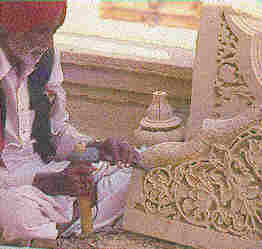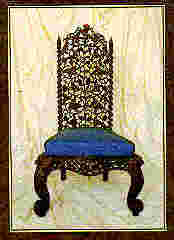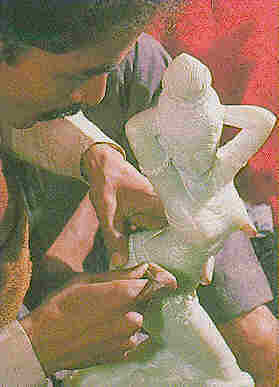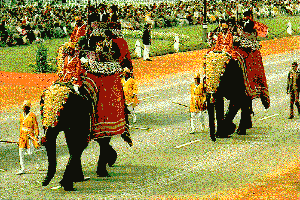
|
Table of Contents
_________________________________________________
In the Indian context the social division of labour into antagonistic caste groupings had two aspects.
 | Such unnamed craftsmen from the artisan castes (jatis) created the grandoise masterpieces of Indian temple architecture. |
The first division took place on the basis of the economic function of the caste-groupings in the context of the role they played in the surplus producing economy of either production of the economic surplus or its appropriation. These two caste-groupings, as we have mentioned earlier were the Vaishya-Shudra producers and the Brahmin-Kshatriya appropriators. This division which was clearly a vertical hierarchy was called the Chatur-Varna i.e. Four Varnas or Castes.
The second division was based on the occupational specialization of the caste-groups and this sub-division took place essentially amongst the Vaishya-Shudra combine, they being the producer categories, this was essentially a horizontal division which was called Jati.
But the Jati division was held together by the Varna division which with its antagonistic interests of sharing the surplus product was a class division in a real sense. The Jati division functioning within the Varna hierarchy represented only an occupational sub-division of what was basically the producing function. The creation of social groups who would undertake production was a logical pre-requisite for an occupational division to take place amongst it. An abstraction of the above process would mean that the Varna division brought forth a class of producers who rendered the social surplus. While the Jati sub-division with its occupational functions created a social structure to render that social surplus in various forms.
 | Wood Carving has been an hoary tradition since vedic times In the Ashramas most of the artefacts were made of wood. |
But the Jati-Varna matrix, although two different aspects of the social division of labour must have taken place as one process. The two divisions were the result of a single momentum which represented the variety and rising productivity of labour. The subjugation of the Vaishyas-Shudras pushed them into a position where they had to render a surplus, this was the Varna aspect of the division, and once having been pushed into this position they rendered the surplus in the form of the product which their particular tribe had been specializing in.
 | Occupational specialization was the essence of the sub-division of the two lower Varnas (castes) of the Vaishyas and Shudras into the various Jatis (occupational sub-castes). |
Towards the final stages of the tribal system different tribes had started specializing in different products which the natural conditions favoured. Hence the Vaishya-Shudra combine rendered the surplus in the form of different products. This occupational division crystallized into the Jati system.The Jati division amongst the Vaishya-Shudras which was based on occupational functions had no conflict of interests inherent in itself, due to the positions they occupied in the production process of 'belonging the productive categories'. The antagonisms to be seen amongst these castes was the creation of the dominant castes who did this by placing some Jatis of the exploited Varna one above the other in the social ladder.
The placing of the shudras above the Ati-Shudras, the Mahars against the Mangs, the Lohars above the Chamars, etc., were attempts to keep the exploited Jatis, a divided house. But the acceptance of such a hierarchy amongst themselves by the exploited Vaishyas and Shudras only represented the success of the ideology of the ruling class over the minds of the exploited class as generally happens in every class society.
 | The manufacture of silk fabric has been a specialized occupation since the last 2000 years in India. The technique of rearing silkworms came from China into India in the 2nd century C.E. |
But in India the acceptance of the ideology of the ruling categories by the general population was ensured by a neat integration of religion into the social structure. The cleverly contrived theory of cycles of rebirth, with the possibility of birth in a higher caste being linked to faithfully carrying out one's duties as per caste rules. The fatalistic acceptance of the membership of a particular caste as a result of deeds in past life. The pseudo-religious practices of untouchability and endogamy which segregated one caste from another, apart from the various social privileges and also laws as provided in our Dharmashastras drilled into the minds of people that caste is a pre-ordained and hereditary institution which has divine sanction.
UNTOUCHABILITY AND ENDOGAMY
Practices like untouchability and endogamy also played a vital role in keeping the hereditary character of the caste system intact for centuries together. And as their function was to hold intact the caste system it is logical that they were introduced after caste divisions had already developed.
 | In ancient times, education in such gurukulas and ashramas was limited to the upper castes only. To sustain such discrimination, the pseudo-religious practices of
untouchability and endogamy were introduced in post-vedic times. The Vedas do not talk of untouchability and endogamy. It is the later Dharmashastras that first mention these practices which segregated one caste from
another. This ideology along with the various unequal hereditary privileges and the discriminatory laws
as provided in our Dharmashastras, drilled into the minds of
people that caste is a pre-ordained and hereditary institution which has divine sanction.
|
It is widely agreed that the Shudra caste of Indian society was largely constituted from the pre-Aryan inhabitants of India who were subjugated by the Aryans. To begin with, it is quite possible that as long as Aryan society had not divided itself into various castes there would have been no logical reason for segregating the non-Aryan conquered races who as per the tribal practice could, as we have discussed earlier, either be eaten or be absorbed into the tribal set up of the conquering Aryans. That some of the conquered non-Aryans were disposed off this way is indicated by the existence of the practice of Purusha-Medha Yagna among the Aryans whose cannibalistic traits are also illustrated by the legend of Chilaya (Srilaya).
But what is more important here is that some of the conquered non-Aryans could have been absorbed into Aryan society. Racial intermixing could also have taken place due to regular pairing between the Aryans and pre-Aryans. That such racial intermixing did take place is indicated by the strict injunctions against intermarriage between Aryans and non-Aryans and later between various castes. The prevention of a particular practice, presupposes its occurance. The rationale for such injuctions against the racial intermixing between the Aryans and the conquered people must lie in the fact that when a social structure developed, with the Aryans occupying the upper echelons, it became necessary to preserve racial purity. Their status of belonging to a particular social category as Brahmins or Kshatriyas had to be preserved. Racial intermixing posed a danger of diluting their favoured position and thus it had to be prohibited. From this reality, arose the doctrines of Untouchability, Unapproachability and Endogamy among various castes. It was these doctrines that gave the feature of heredity to the caste system which was further cemented by ideas of birth one' s in a caste depending on one's deeds in a past life and re-birth in a higher caste if one strictly adhered to caste rules in one's present life.
Caste in the Middle Ages
This feature of heredity gave a kind of permanence to the caste system.
 | The earliest forms of settled occupations (in Vedic times) were those of handicrafts. In later times such occupational specialization became a hereditary occupation. |
The economic system of village self-sufficiency which existed in India Over a large period of our history further strengthened the caste system. The self-sufficient village economies required the functional-occupational division of labour to support the system of barter-exchange of products amongst the different artisanal castes and cultivators of a village.
Every village required an artisan member of every caste to fulfil its need in the absence of exchange and trade. The process of exploitation of the productive castes through the appropriation of their surplus production was performed by the hierarchical administrative apparatus of the feudal state.
 | Such exquisite craftsmanship was a result of generations of specialization. However, it had its downside socially. The feature of heredity came in very handy to preserve the caste system over countless generations, as the right to practice a particular occupation was tethered to birth in a particular caste Jati). Expulsion from a caste meant expulsion from the caste system itself. And such expulsion deprived the expelled person from his only source of livelihood as he could no longer practice the occupation of the caste from which he had been expelled, neither could be become a member of any other caste as membership of a caste could be acquired only by birth in that caste.Hence expulsion form caste meant expulsion from life itself. |
In the Middle ages,the Choudharys, Thakurs, Deshmukhs, Desais and above them the Brahmin donees (receivers) of Brahmadeya, Agrahara and Devadana lands whose place was later taken by the Jagirdars and Subahdars during the Mohammedan Rule, were the categories who shared in the appropriation of the surplus product that accured at the lowest level through the inequitable rules of the caste system.
The upper intermediaries like the Brahmin donees or later the Jagirdars received their share of the surplus through tithes and Taxes. The share of the nobility was allocated to them as a right (or more or less as a favour for services rendered) by the king. The class of lower intermediaries, the Deshmukhs, Desais and Choudharys were entitled to a smaller portion of the revenue collected through taxes. But the major part of their share in the surplus accrued to them through the Jajmani (Yajamani) system (or Bara-Balutedar system as it was known in Western India) of barter-exchange of the surplus product from the various producing castes in a village. These village chiefs received their share as payment or rather compensation in the form of a right, for the services they rendered as administrators of the village. In actual fact they were a non-productive class whose function was to collect taxes to be passed on to the higher-ups like the Jagirdars and Subahdars. Thus the share of the social surplus which they obtained can legitimately be termed 'feudal privilege'.
 | The Buddhist reform tried to obliterate the caste system. But the system of class division and caste specialization was a result of historic inevitability due to the development of productive forces. In those days, if society had to advance economically, then some kind of a social and occupational division was necessary. In ancient Greece and Rome it took place as a division between slaves and masters. In ancient India it took place in the form of the caste system. Secondly, some force - social, religious, psychological, physical or political was necessary to hold this division of society, for furthering of economic progress. In India, the system was held together with the caste system and the belief of birth and re-birth. In the west it (slavery) was held together with the help of the master's whip. |
To hold together the caste (Jati) system with its occupational stratification, the feature of heredity came in very handy as the right to practice a particular occupation was tethered to birth in a particular caste Jati). Expulsion from a caste meant expulsion from the caste system itself. And such expulsion deprived the expelled person from his only source of livelihood as he could no longer practice the occupation of the caste from which he had been expelled, neither could be become a member of any other caste as membership of a caste could be acquired only by birth in that caste. Once a person was expelled from the caste system he was socially ostracized and even if he did try to continue practicing his caste-vocation, the village folks refused to patronise him.
Thus being expelled from caste was as good as being expelled from society itself. A case in point is the expulsion from the Brahmin caste of Saint Dyaneshwar's father because he returned to the life of a Grihastha (householder) after once having fosaken material life and taken up Sanyasa . For this he was looked upon as apostate and was expelled from his caste after which life was so unbearable for him that he preferred to commit suicide along with his wife, leaving behind four infant children to fend for themselves.
Thus explusion from a caste was as good as passing a death sentence on the person concerned. Only the membership of a caste entitled a person to practice the vocation allotted to that caste under the caste system. This kind of a relationship between occupation and caste made it in the direct interests of members of various castes to observe the caste vocations strictly and thus also the caste system. Infringement of caste rules of vocation could lead to expulsion thus a Chamar (shoe maker) had to remain a Chamar all his life, if he tried to become. a Kumar (potter) or Darji (tailor) he was in danger of being expelled from the Chamar caste and obviously under the caste rules he would not be admitted into any other caste in spite of his having the knowledge of any other vocation. This also meant that every member of a caste had to observe all other caste rules like untouchability, unapproachability, endogamy, etc., under the threat of expulsion from his caste if he dared to break the caste rules.
 | The craftsmanship that resulted from the hereditary caste system was superb in its finesse. However, it created watertight social compartments within which all members of society were compelled to remain. Thus membership of a caste, which was an accident of birth was made a life-long accompaniment by the morality of the caste system. |
This cleverly contrived matrix of social relationships enabled the voluntary acceptance of the caste system with all its unequal qualifications by the productive castes at large for centuries together.
CASTEISM TODAY
Because of the feature of heredity and the integration of religious dogmas the caste system, it could survive over thousands of years in an almost unchanged form. Even today when the economic basis of society has changed and castes no longer have any occupational relevance casteist feelings continue to persist. This is so as apart from being an occupational division among society caste was tethered to birth and was given a pseudo-religious stature through practices like untouchability and endogamy. This is clearly seen during elections, when votes are openly solicited n caste grounds and terms like "caste equations" and "caste arithmetic" are used in the media till today.
 | Continuity and Change: Caprisoned Elephants, lumber along the Raj Path in New Delhi as a part of India's Republic Day parade. |
Thus inspite of having lost its economic relevance, casteist feelings continue to impose an irrelevant psychological division amongst Indians today. Even in our private lives we practice endogamy during match-making for marriages in the family. In villages, the more backward still observe untouchability and unapproachabillty. Some Indians today mistake the existence of castiest feelings like untouchability and endogamy with the existence of the caste system itself. It is necessary here to repeat that untouchability and endogamy were social practices to sustain the caste system which comprised production and exchange relations which meant the hereditary adherence to a particular vocation and the obligatory sharing of the products made by the lower castes with the upper castes. This sharing was either free in the form of taxes, tithes, free labour as a feudal privilege or through customary charity to Brahmins and to temples (which meant indirectly to the Brahmins in charge of the temples).
The practices of untouchability unapproachability and endogamy were devised to hold intact the above set of production and exchange relationships which the caste system constituted.
While these practices of untouchability and endogamy were meant to hold together the caste system, they survive today when the caste system no longer exists as a institution of production and exchange relationships. But in this scenario it cannot be said that the caste system exists today. What exists are casteist feelings of belonging to a certain caste. We consider ourselves to be Brahmins - but we no longer took after temples, we consider ourselves Khatris - but we are not in the Army, we consider ourselves chamars - but we do not function as cobblers, etc. What also exists today are casteist practices like those of untouchability (in rural areas) and endogamy though Caste as a system of occupational heredity and a matrix of production and exchange relationships which needed such practices has itself disappeared.
_________________________________________
Now we move on to examine the social origins of various Hindu Festivals like Diwali, Dusshera and Holi.
_____________________________________________________________
_____________________________________________________________________________________
|
|
_ _ _ |
View My Guestbook
|
_______________________________________
_________________________________
